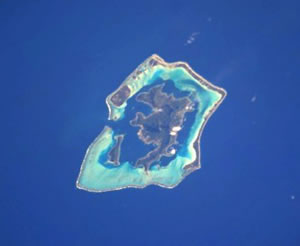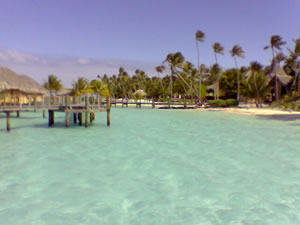American author James Michener described Bora Bora, which lies 225km (140mi) northwest of Tahiti, as the "most beautiful island in the world."
Shady palm trees line the sandy beaches of this 6.5km (4mi) by 4km (2.5mi) island. Rugged mountain peaks, full of sheer cliffs and steep chasms, are covered in rich, tropical vegetation. The mountains overlook the calm, blue waters of a lagoon.
 Bora Bora is surrounded by a colorful coral reef that protects it from the large waves of the Pacific.
Bora Bora is surrounded by a colorful coral reef that protects it from the large waves of the Pacific.
It is one of the Society Islands, part of French Polynesia, and one of many volcanic islands scattered across the South Pacific.
Bora Bora was formed after a series of volcanic eruptions on the ocean floor caused lava to break through the surface of the ocean.
 At one time, Bora Bora towered 1,200m (4,000ft) above the surrounding sea and 5,400m (18,000ft) above its base.
At one time, Bora Bora towered 1,200m (4,000ft) above the surrounding sea and 5,400m (18,000ft) above its base.
When the volcano became extinct, no fresh lava added to Bora Bora's size and the forces of erosion took over. Wind and rain wore away softer rocks, leaving harder stone to form a tall, jagged outline.
The sea invaded the crater of the volcano, pounding away at its shoreline.
The peaks of Taimanu and Pahia, rising more than 655m (2,100ft) above sea level, are all that remain of the north rim of the crater.
The volcano is subsiding as well as being eroded. In a few hundred thousand years, its remnants will disappear beneath the water of the lagoon.
Coral Reef
A vast number of tiny coral larvae, which are related to the sea anemone, live in the tropical seas of the Pacific. They drift in the ocean currents until they find a hold on a solid shelf, where the waters are clear, shallow and well oxygenated.
Each coral larva metamorphoses into a cup-shaped polyp about 2mm (0.08in) across. The upper side of the polyp is open and serves as a mouth; a ring of tentacles catches microscopic food particles and directs them into the opening.
The polyps extract calcium from seawater, which they use to grow hard limestone shells around the lower halves of their bodies. Once they establish themselves in a favorable spot, the polyps rapidly divide, creating new individuals and form a spreading mass of stony coral.
Over thousands of years, these coral have formed an almost circular coral reef around the underwater slopes of Bora Bora's volcano.
The coral reef appears as a continuous chain of small islands called "motus", which protects the tranquil waters of the lagoon from large Pacific waves.
Only one gap, Teavanui Pass, provides a passageway for ships to reach the island.
Within the colorful reef, branching coral polyps form extensive but delicate forests while bulky types form great masses of solid limestone.
Many animals depend on the coral reefs, as a source of food as well as a place to hide from predators or to wait for prey.
Shellfish, such as sea snails, cowries and bivalves, move slowly through the coral gardens while giant clams, up to 1.2m (4ft) across, filter the water for food.
Sharks and barracudas, often more than 2m (6.6ft) long, lurk in the shallows searching for prey.